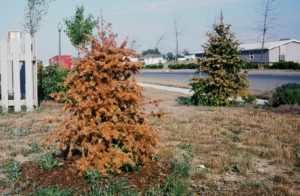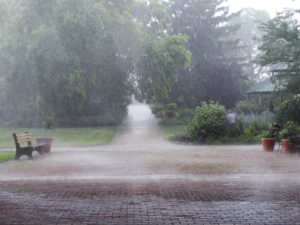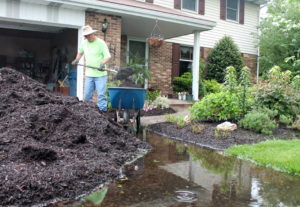The WOOPS Way to Predict Weather
July 28th, 2020
Forget AccuWeather, the National Weather Service, and even the Farmer’s Almanac.
If you’re a gardener and you really want to figure out what weather’s on the way, the most accurate system is one I’ve figured out… one I call the “WOOPS model of weather forecasting.”
I’ve been using it for years, and I’ve found it’s the most accurate, laser-focused way to predict the weather – right down to what’s coming to your specific yard.
WOOPS stands for “Weather Opposite Of Plant Situations.”
It’s based on the principles of Murphy’s Law and has only two simple factors: 1.) determine what weather you really need at the moment, and 2.) expect the opposite.
The most glaring example is the weather we’ve had for most of this month.
If you watched the “regular” forecasts like a hawk, you probably had your green-lawn hopes raised by the almost daily predictions of thunderstorms – often 30 to 50 percent chances.
Statistically, that means a storm should pan out on at least one out of every two or three days.
I don’t know about you, but the storms missed my yard every time.
That didn’t surprise me because my WOOPS model expected absolutely no meaningful rain, based on the fact that I just got done planting a whole yard full of new plants.
New plants need a lot of water regularly, so what I really needed this summer was a summer like the past two – wetter than usual.
WOOPS told me that wasn’t going to happen, so I was able to forecast a brutally hot and dry summer of 2021 as far back as last year, when I cleared out the jungle I inherited in order to plant this spring.
WOOPS forecasts become even more accurate the higher that water bills go. Since my sewer-attached water bills in Pittsburgh are incredibly higher than my former Hampden Twp. water, sewer, and trash costs combined, I knew a dry summer was a lock.
To put WOOPS simply, if you need rain, you’re going to get dry. I’ve had people in the Dillsburg area tell me that when they get into a dry spell, they can watch the weather radar and actually see storms split apart so the rain misses their yards right down the middle.
Of course, the opposite happens when it’s wet and rainy.
When the ground is already soggy, you can bet you’re going to get more soaking rain… even when there’s slim to no chance of it mentioned in the “regular” forecast.
The past two summers are good examples. We got one rain after another. No storm missed.
At my house, we got five different “gully-washers” last summer.
WOOPS told me those were coming, too, because I cleared the jungle from my back bank but didn’t have the time or energy to plant it. I put down a few inches of leaf compost to help with plans to improve the soil and to plant this spring.
Soon after the compost was down – you guessed it – we got a huge downpour that turned the bank into Niagara Falls. It was like someone was holding a giant fire hose at the top, blowing a ravaging watery swath down the middle and dumping half of my bucket-carried compost onto my back lawn.
So I raked the compost, carried it back into place, and proclaimed, “I hope THAT doesn’t happen again!”
That’s the kiss of death in WOOPS forecasting. Just a day later, another mammoth downpour came, carrying even more of the compost back down the bank.
That happened three more times, which led me to dig a back-breaking pit and trench system along with laying shredded hardwood mulch (which knits into place) before planting.
I’m thinking a good test would’ve been to let the bank alone again and to plant the front yard. Would I get more gully-washers out back but no rain at all out front?
I’ve seen WOOPS in action enough over the years, though, that I know it seldom misses.
Whenever I order a pile of mulch, for example, it’s guaranteed to rain about five minutes after the pile is on the driveway… even when no rain is in the “regular” forecast.
It never waits until the mulch is spread and rain would be helpful in cooling steamy mulch or dissipating the plant-harming off-gassing that can happen when mulch piles aren’t regularly turned.
WOOPS also came through this May when so many gardeners planted their annual flowers just before Mother’s Day, figuring that was late enough since so much of the year was warmer than usual. (We started the year with Harrisburg’s 10th warmest January, then had the fifth warmest February on record, then had a March that was six degrees above normal.)
True to WOOPS form, we set a record low of 30 degrees on May 10 – cold enough to kill lots and lots of those begonias, zinnias, peppers, tomatoes, etc.
And I’ve learned from experience to always, always, always water any new plant immediately after planting. Even if the “regular” forecast says there’s a 100 percent chance of rain, WOOPS told me that it isn’t going to happen if I plant and walk away to let nature take its course.
So what does my WOOPS crystal ball see for the rest of this year?
I’m thinking we’ll stay dry until summer ends, then it’ll rain and rain and rain to make our annual rainfall total for 2021 look close to normal.
The other thing that could happen is that once we get a good soaking rain or two, 10 more will follow to turn our worries from drought to root-rot.
As for winter, if the coronavirus is still lurking and people are staying at home, WOOPS tells me we won’t have much snow. What’s the point of snow if there’s no travel to disrupt?
However, if we somehow get rid of the virus threat and we all take to the roads and airways again, then watch for a WOOPSy DAISY (“Darned Awful Intensely Snowy Year”).










